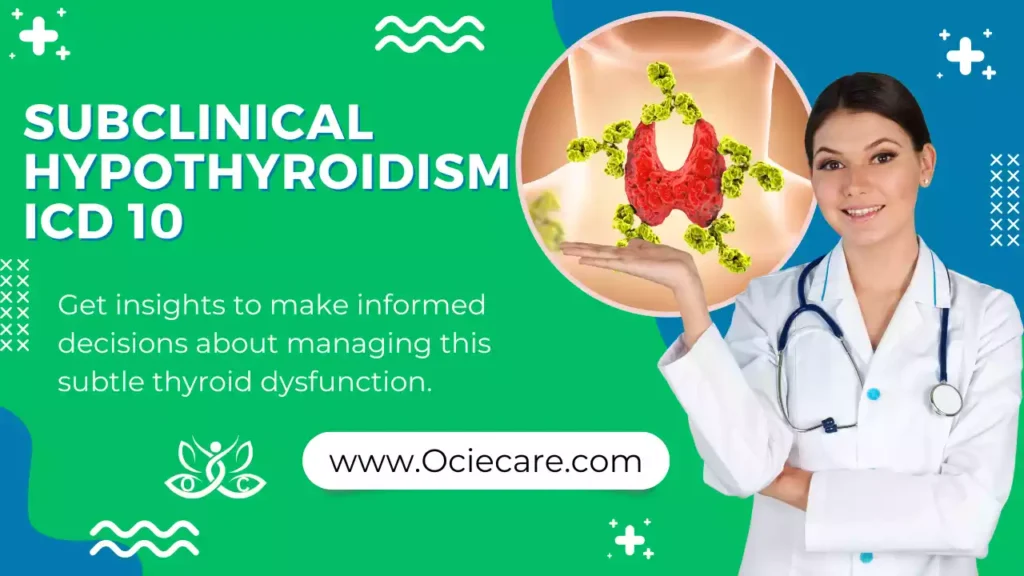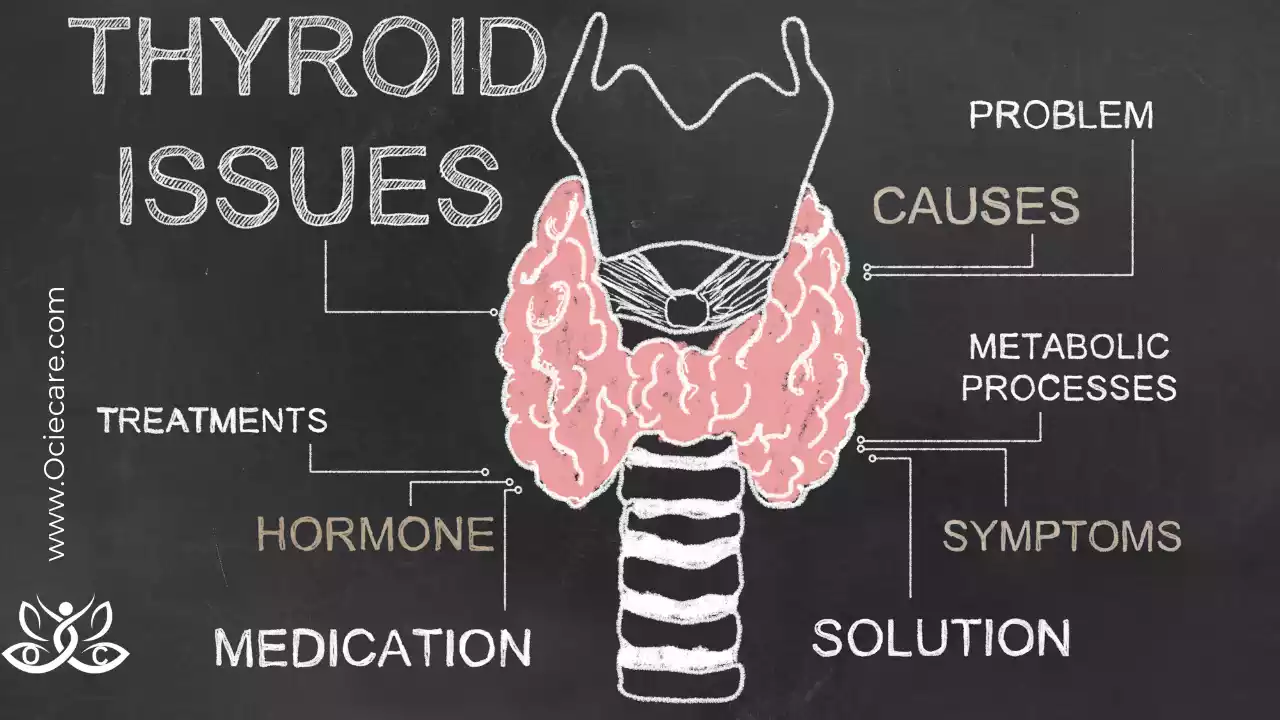Learn about subclinical hypothyroidism icd 10, a thyroid disorder with slightly elevated TSH levels and normal thyroid hormone levels. Explore its causes, symptoms, treatment options, and when intervention might be necessary. Get insights to make informed decisions about managing this subtle thyroid dysfunction.”
Introducing subclinical hypothyroidism icd 10, a thyroid condition characterized by mildly elevated thyroid-stimulating hormone (TSH) levels and normal thyroid hormone levels. Delve into its nuances, from causes to potential treatments, and gain a deeper understanding of this subtle thyroid disorder.

Subclinical Hypothyroidism icd 10: An Overview
Subclinical Hypothyroidism icd 10 is a condition characterized by slightly elevated levels of thyroid-stimulating hormone (TSH) in the blood, along with normal levels of thyroid hormones, thyroxine (T4), and triiodothyronine (T3). This condition falls within the spectrum of thyroid disorders and is often detected through routine blood tests.
It’s important to note that not everyone with subclinical hypothyroidism will require treatment, as the management approach can vary based on individual factors.
Subclinical Hypothyroidism icd 10: Normal and Abnormal Parameters:
Normal Parameters:
I. TSH Levels:
- Thyroid-stimulating hormone (TSH) is produced by the pituitary gland to signal the thyroid to release thyroid hormones.
- In a healthy individual, TSH levels typically fall within a reference range of around 0.4 – 4.0 milli-international units per liter (mIU/L).
- This range may vary slightly depending on the laboratory and the population being tested.
II. T4 and T3 Levels:
- Thyroxine (T4) and triiodothyronine (T3) are the two main thyroid hormones that regulate various metabolic processes in the body.
- In a normal state, the levels of T4 and T3 remain within the established normal range.
Abnormal Parameters:
I. Elevated TSH Levels:
- In cases of subclinical hypothyroidism, the TSH levels are elevated beyond the upper limit of the reference range (typically above 4.0 mIU/L).
- This elevation indicates that the thyroid gland is not producing enough thyroid hormones to meet the body’s needs.
- However, T4 and T3 levels remain within the normal range.
- This situation suggests that the thyroid gland is starting to struggle but hasn’t reached a point where it’s causing noticeable symptoms of hypothyroidism.
II. Normal T4 and T3 Levels:
- Despite the elevated TSH, the levels of T4 and T3 remain within the normal range.
- This is what differentiates subclinical hypothyroidism from overt hypothyroidism, where both TSH and thyroid hormone levels are outside the normal range.
In summary, subclinical hypothyroidism is characterized by elevated TSH levels and normal T4 and T3 levels. This suggests that the thyroid gland is under some strain and the body is responding by increasing TSH production to stimulate more thyroid hormone production.
However, since T4 and T3 levels are still within the normal range, individuals with subclinical hypothyroidism may not exhibit the typical symptoms associated with full-blown hypothyroidism. It’s a subtle state of thyroid dysfunction that often requires monitoring and consideration of various factors before deciding on a treatment approach.
Common Diagnostic and Monitoring Tests of Subclinical Hypothyroidism icd 10
Routine blood tests are the primary method for diagnosing and monitoring Subclinical Hypothyroidism icd 10. The key test used in this process is the measurement of thyroid-stimulating hormone (TSH) levels in the blood. TSH is produced by the pituitary gland and stimulates the thyroid gland to produce and release thyroid hormones (T4 and T3).
TSH Test:
- The TSH test involves drawing a blood sample from the individual, usually from a vein in the arm.
- This blood sample is then sent to a laboratory for analysis.
- The TSH test measures the concentration of TSH in the blood, which indicates how well the thyroid gland is functioning.
- In the context of subclinical hypothyroidism, elevated TSH levels are a key indicator. An elevated TSH level suggests that the thyroid gland is not producing enough thyroid hormones to maintain normal levels in the bloodstream.
- The higher the TSH level, the more the pituitary gland is trying to stimulate the thyroid to produce more hormones. This is the body’s way of compensating for the decreased thyroid function.
Interpreting the TSH levels requires considering the specific reference range provided by the laboratory. Generally, TSH levels above the upper limit of the reference range (such as above 4.0 mIU/L) are indicative of subclinical hypothyroidism.
The TSH test is a valuable tool for diagnosing Subclinical Hypothyroidism icd 10 and monitoring its progression. It helps healthcare professionals assess the thyroid’s functioning and determine whether intervention is necessary, especially if TSH levels continue to rise or if symptoms of hypothyroidism develop.
It’s important to note that the TSH test is typically the initial step in diagnosing thyroid-related disorders, and additional tests may be performed to gather a comprehensive understanding of the individual’s thyroid health, such as thyroid hormone (T4 and T3) levels and thyroid antibody tests.
Specialized Investigations of Subclinical Hypothyroidism icd 10
When diagnosing and managing Subclinical Hypothyroidism icd 10, healthcare professionals may use specialized tests and procedures to gain a more comprehensive understanding of the condition and its underlying factors.
Thyroid Ultrasound:
- A thyroid ultrasound is a non-invasive imaging technique that uses high-frequency sound waves to create detailed images of the thyroid gland’s structure.
- During the procedure, a handheld device called a transducer is placed on the neck, and sound waves are transmitted into the body. These sound waves bounce off the thyroid tissue and are converted into images on a computer screen.
- Thyroid ultrasound can provide valuable information about the size, shape, and texture of the thyroid gland. It can also help identify any structural abnormalities, such as nodules or cysts.
- In the context of subclinical hypothyroidism, a thyroid ultrasound can help rule out any visible structural issues that might be contributing to the thyroid’s decreased function.
Thyroid Antibody Tests:
- Thyroid antibody tests are blood tests that specifically check for the presence of antibodies that target components of the thyroid gland.
- Two common types of thyroid antibodies are thyroid peroxidase antibodies (TPOAb) and thyroglobulin antibodies (TgAb).
- Elevated levels of these antibodies can indicate autoimmune thyroid conditions, such as Hashimoto’s thyroiditis. In this condition, the immune system mistakenly attacks the thyroid gland, leading to inflammation and impaired thyroid function.
- The presence of thyroid antibodies can provide valuable information about the underlying cause of subclinical hypothyroidism, especially if an autoimmune component is suspected.
These specialized investigations, including thyroid ultrasound and thyroid antibody tests, allow healthcare professionals to gather more information about the underlying causes of subclinical hypothyroidism.
By assessing the thyroid gland’s structure and identifying autoimmune factors, these tests contribute to a more accurate diagnosis and guide the appropriate treatment approach, especially when considering whether hormone replacement therapy is necessary.
Typical Laboratory Findings of Subclinical Hypothyroidism icd 10
Laboratory tests often reveal:
- Elevated TSH levels above the normal range.
- Normal T4 and T3 levels.
- Absence of overt symptoms of hypothyroidism.
Treatment Approach of Subclinical Hypothyroidism icd 10

The approach to treating subclinical hypothyroidism is individualized and takes into consideration various factors, including the person’s age, overall health, TSH levels, and the presence of any symptoms. The main goal of treatment is to improve the individual’s overall well-being and prevent the progression of thyroid dysfunction.
Observation:
- In cases where TSH levels are only mildly elevated and there are no noticeable symptoms, a strategy of close observation may be recommended.
- The healthcare provider will monitor TSH levels over time to assess whether they remain stable or continue to rise. Regular follow-up appointments and blood tests are essential to track any changes.
- Observation is often considered when the elevation in TSH is minimal and there’s no immediate risk to the individual’s health. This approach avoids unnecessary treatment interventions.
Hormone Replacement Therapy:
- If TSH levels are significantly elevated or if the individual is experiencing symptoms associated with hypothyroidism, hormone replacement therapy may be considered.
- The most common medication used for hormone replacement therapy is levothyroxine, which is a synthetic form of the thyroid hormone thyroxine (T4).
- The goal of hormone replacement therapy is to bring TSH levels back to the normal range and alleviate any symptoms that the individual might be experiencing.
- The dosage of levothyroxine is carefully adjusted based on the individual’s TSH levels and response to treatment. Regular monitoring is essential to ensure that TSH levels are properly regulated.
Considerations:
- The decision to initiate treatment depends on a balance between the potential benefits and risks of intervention. It’s important for the healthcare provider to discuss the pros and cons of treatment with the individual.
- Factors such as age, overall health, the presence of underlying medical conditions, and individual preferences play a role in determining the appropriate treatment approach.
- Some individuals with subclinical hypothyroidism may have a greater likelihood of progressing to overt hypothyroidism over time, while others may not experience any significant changes in their thyroid function.
The treatment approach for Subclinical Hypothyroidism icd 10 is not one-size-fits-all. It’s based on a careful assessment of the individual’s condition and circumstances. Whether it involves close observation or hormone replacement therapy, the ultimate aim is to optimize thyroid function and improve the individual’s quality of life.
Consultation with a qualified healthcare provider is crucial to determine the best course of action for managing subclinical hypothyroidism.
Conclusion:
Subclinical Hypothyroidism icd 10 is a condition characterized by elevated TSH levels and normal thyroid hormone levels. While it may not always require treatment, close monitoring, and individualized management are essential to prevent potential complications and ensure optimal health. Consulting a healthcare professional is crucial for accurate diagnosis and appropriate management strategies.
FAQs
Q. What is Subclinical Hypothyroidism icd 10?
A. Subclinical hypothyroidism is a thyroid disorder characterized by slightly elevated levels of thyroid-stimulating hormone (TSH) in the blood, along with normal levels of thyroid hormones T4 and T3. It’s a milder form of hypothyroidism where TSH is elevated but thyroid hormone levels remain within the normal range.
Q. What causes Subclinical Hypothyroidism icd 10?
A. Subclinical hypothyroidism can be caused by various factors, including autoimmune conditions like Hashimoto’s thyroiditis, certain medications, aging, and even temporary issues like pregnancy. It’s important to evaluate the underlying cause to determine the appropriate treatment approach.
Q. Do all cases of Subclinical Hypothyroidism icd 10 require treatment?
A. No, not all cases require treatment. The decision to treat subclinical hypothyroidism depends on factors such as TSH levels, the presence of symptoms, and individual health status. Mild elevations in TSH without symptoms might only require close monitoring, while more significant elevations or symptoms might warrant treatment.
Q. What symptoms are associated with Subclinical Hypothyroidism icd 10?
A. Subclinical hypothyroidism may not always cause noticeable symptoms. However, if symptoms do occur, they can include fatigue, mild weight gain, sensitivity to colds, and slight changes in mood and cognition. These symptoms are often less pronounced than those seen in overt hypothyroidism.
Q. Is hormone replacement therapy necessary for Subclinical Hypothyroidism icd 10?
A. Hormone replacement therapy with levothyroxine might be considered for individuals with significantly elevated TSH levels or bothersome symptoms. However, it’s not a one-size-fits-all approach. For those with only slightly elevated TSH levels and no symptoms, close observation might be recommended to determine if treatment is necessary.
You may also like to know:
- Uterine Fibroids | The Natural Solution In 21 Days
- Pelvic Organ Prolapse: Natural Treatment Without Medicine In 2023
- Blood Sugar | Diabetes: Understanding, Treatment, and Prevention In 2023
Your article helped me a lot, is there any more related content? Thanks!